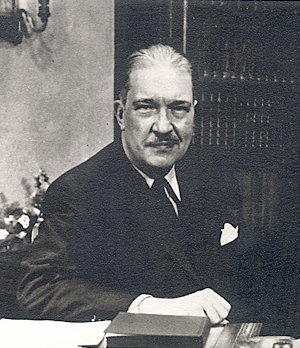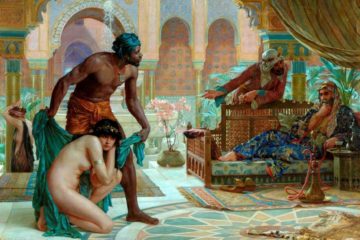The Making of Mythidia
 by Revilo P. Oliver (pictured)
by Revilo P. Oliver (pictured)
‘MYTH’ would be too pretentious a word for what I have in mind, so I have taken the Greek diminutive, “mythidion,” which I first learned from Lucian and, appropriately, from his dialogue, Philopseudes, in which he discusses the origin and prevalence of lies. I shall consider here, briefly, what we may call, by an oxymoron, involuntary lies, i.e., untruths, falsehoods, told by persons who do not intend to deceive and whose evident good faith induces their acquaintance to give credence to false statements which they will, in turn, repeat as matters of fact, thus often giving them a wide circulation.
In an earlier issue of Liberty Bell I noticed a typical mythidion, a story about the origin of Bartholdi’s colossal statue of Eleutheria in the harbor of New York City, which had been so widely disseminated that it was repeated to me for my information in all good faith by several correspondents. The story was certainly false, but had its origin in a confusion between a colossal statue the sculptor projected but never executed and the one he did produce for export to the United States.
The simplest and clearest illustration of the generation of such mythidia is one that first made me realize the importance of keeping always in mind how extremely common are the consequences of a psychological phenomenon that encompasses us with traps for the unwary.
A valued friend of mine, an attorney of standing, was wont to tell his friends, whenever the conversation turned to the various Christian cults and their gospels, that his great-grandfather had been personally acquainted with the blacksmith who forged the golden plates from which Joseph Smith pretended to translate the Book of Mormon.
Now that story was obviously false. According to the official doctrine of the Mormon Church, Smith was led, by an angelic Mentor, to discover in a cave near Palmyra, New York, a horde of tablets, made of solid gold, bearing inscriptions which he transcribed in English by looking through a magic stone which converted the Egyptian characters and language into English. As soon as this godly work was completed, the Angel Moroni appeared and took the golden plates, which were too precious to be entrusted to mortals, back with him to Heaven for safekeeping, perhaps in some celestial lock-box. Anyone with a modicum of common sense knows, of course, that the “golden plates” were just a fiction imagined to validate a hoax. Therefore no one could have manufactured them, and assuredly no blacksmith ever hammered out a mass of gold that must have been worth at least several million dollars even at that time, when dollars were real money and not just pieces of colored paper used in the great American swindle.
A few questions, however, sufficed to show that my friend’s story about his great-grandfather was largely true. His great-grandfather never lived in New York and was not known ever to have visited that state, but, in the course of his business, he traveled widely in the state of Illinois. In that state there is a tiny village named Kinderhook. (A friend of mine says, with slight hyperbole, “You won’t notice it unless you drive slowly.”) It is directly east of Hannibal, Missouri, and about six miles from the Mississippi River. It was, however, a town of some importance in the first part of the Nineteenth Century, when one of the inhabitants was Robert Wylie, a prosperous merchant and wealthy landowner.
One day in April 1843, when he and a friend, Wilbourne Fugate, were discussing religion and especially the new Mormon cult which was gaining so many adherents, Wylie, perhaps influenced by the spirituous inspiration that is so commonly mistaken for spiritual, decided to test by experiment how much suckers can be made to believe. They enlisted the services of Bridge Whitton, who appears to have been the local blacksmith, and who made for them six thin plates, roughly campanulate in shape, of a then common alloy that metallurgically was something between bronze and brass, as those metals are strictly defined. Wylie and Fugate then coated both sides of the metal plates with beeswax and scratched through the wax the most mysterious ‘hieroglyphs’ they could devise. They then applied nitric acid to the plates, thus etching the symbols in the metal. Removing the wax, they covered the plates with ‘rust’ that they manufactured by using nitric acid on pieces of iron and lead, and bound the plates together with an iron ring, which they also covered with the spurious rust, thus producing an appearance of great antiquity and long burial in the ground. The plates were planted in an excavation Wylie was having made on his property and were placed under a stone a foot or two beneath the depth the workmen had reached when they stopped work for the day. The sportive gentlemen arranged to have a number of their fellow citizens, including two Mormon elders, on Wylie’s property the next day when the workmen, resuming work, discovered the amazing memorials left by some prehistoric people, and the spectators marvelled at the hieroglyphs, which, like the sacred writing of Egypt, must have been used by priests to preserve religious texts. Seven respected citizens, who had been present when the momentous discovery was made, signed a document attesting the finding of the plates, “covered with ancient characters” and of great antiquity, since they had obviously been buried in the ground for a very long time.
Wylie and Fugate enjoyed their hoax, which they, according to one account, found unexpectedly and handsomely profitable, and they probably hoped to catch prize suckers who were nationally known before they began to laugh openly at human credulity.(1) Whitton, the blacksmith, seems to have been the first to expose the hoax, of which he told one of the dupes who had signed the document. That man was not amused.
Wylie eventually gave the plates as curiosities to a certain Professor McDowell in St. Louis, and they were lost during the war of aggression begun by Lincoln in 1861. By that time, Wylie and Kinderhook’s brief season of glory had been completely forgotten.
We may regard it as certain that my friend’s great-grandfather had known Whitton, and he doubtless told his family with gusto about the hoax of the forged and planted ‘bronze’ plates. No doubt, someone who heard him tell the story, recalled years later only that a blacksmith had forged plates which purportedly bore a religious text written by prehistoric inhabitants of North America; he naturally associated the story with the only famous hoax that involved such a use of supposititious plates, and thus assumed that the blacksmith must have worked for Joseph Smith.
Such was the genesis of that mythidion. When stories are transmitted orally, there is an inevitable slippage as some facts are forgotten and replaced by what seems right or at least plausible to the next narrator.
A man’s memory is itself labile, and facts that are not of vital importance to an individual undergo a strange sea-change as they are submerged in the ocean of subsequent events and, like the bones of Ferdinand’s father, they are made into coral at full fathom five. I give the following example only because it is one of which I can be quite certain of the facts.
A decade ago, my wife was given a copy of William F. Buckley’s Airborne (New York, Macmillan, 1976) by an amiable young lady who had seen my name in the book. In those entertaining memoirs of a yachtsman, the reader is told that I, “at age seventeen, resolved never again to make a typing mistake. Forty years later, he has yet to make one.” The author proceeds to confute persons who doubt my phenomenal ability: “If Horowitz can play at hurricane speed horribly intricate pieces of music, using ten fingers simultaneously without making a mistake, why should Revilo Oliver — a full professor in the classics, master of seventeen tongues(2) — make a mistake, typing at his own speed, and using, at “whatever” speed he typed, what comes down to “only one finger at a time?” (His emphasis.) The argument, I grant, is irrefragable, and I feel humbly apologetic that it failed to convince me.
Such flattery should be convincing, but I could only be grateful. After I reread that passage, I, like Sandy McTavish, put down a slug of Glen Livet just to make certain I was sober, and then I tried to make a spectroscopic analysis of the strange amalgam. Like many chemical compounds, such as dynamite, it is much more than the elements from which it was made.
The four elements are all commonplace, videlicet:
1. When I was “seven,” I was given a present that I especially wanted, a typewriter. (It was a Smith Premier, a machine which had no shift key, since each character was on a separate typebar, making eight rows of keys to provide capitals, lower case, numerals, punctuation, etc., including the fractions by eighths.) I began to write on the typewriter by using only my index fingers, necessarily in alternation and thus “only one finger at a time.” By the time I entered a school in which the “touch system,” using all fingers, was taught, the habit had become so fixed that I never underwent the agony of breaking it.
2. When I was “seventeen,” I purchased a special model of the Hammond Multiplex, a kind of typewriter that was later called Varityper. Its type was on curved plates, two of which could be kept in the machine at one time, so that it was in that respect far superior to the “I.B.M. Selectric” now in use. It had only three rows of keys, but the special model had five shift keys, four of which could be used together (the fifth was used with very large type). The multiple shifts made this the only kind of typewriter on which one could write elaborate mathematical formulae accurately, and also almost all languages that use an alphabetic script, since special type-plates were available for each. It was the only typewriter on which one could write Sanskrit in the Devanagari characters. I eventually collected about sixty type-plates, including several sizes and styles of type for some languages, since the machine would type ten, twelve, or fifteen letters to the inch. (The machine, by the way, is still serviceable; it has deteriorated less than its operator, who no longer has the nervous stamina to use it.)
3. When I was in my twenties, I won a bet by typing with my two fingers as fast and as accurately as a professional stenographer, i.e., a woman who earned her living as an ordinary typist. Neither of us was impeccable, but we made about the same number of mistakes.
The foregoing I doubtless told Buckley at some time or other during our fairly long association.
During its early years, I wrote rather extensively for Buckley’s National Review, and all my faculties were still unimpaired, for I had not yet gone over the pass and started on the ever steeper downslope of life. I have a vague recollection that some member of the staff, who prepared copy for the printers, used to say that I was the only contributor in whose manuscripts he had never found a typographical error. That, of course, was not because I never made “typing mistakes,” but because I read the typewritten text carefully and I was still young enough to be a good proofreader, even of my own writing.
Now all this is interesting only as an example of how even a keen mind can, after almost twenty years, fuse together four trivial details and overlay them with the coral of a sea-change (appropriate for a yachtsman!) to make something phenomenal and, I am afraid, incredible.
Notes
(1) We may guess what Wylie was especially awaiting. There is good evidence for what seems unbelievable prima facie. The Mormon elders who were present at the momentous discovery “leaped and shouted for joy” because Smith’s story was thus corroborated, and the wondrous plates were eventually sent to Smith in his religious capital, Nauvoo. The Prophet recognized the ‘hieroglyphics’ as “reformed Egyptian” and found that the text was the history of an early American, “a descendant of Ham, through the loins of Pharaoh, king of Egypt.” Needless to say, Joseph Smith was not taken in by a parody of his own hoax. Although uneducated and ignorant, he was a man of native ability and a first-class theologian, as is shown by his achievement in composing, from quite diverse sources, some of the best gospels ever written. We can only wonder what would have happened, if Joseph Smith had not been murdered by a mob incited and led by clergymen who wanted to stamp out their most formidable competition in the salvation-business. It is likely that he had diligently informed himself of the circumstances of the discovery and had a copy of a document Wiley and Fugate had rashly signed themselves, and had he lived to complete his “translation” of the text in “reformed Egyptian,” they might have found themselves hoist with their own petard and exposed by divine revelation as infidels and recreants, who had been suborned by Satan to deny their own discovery of revealed truth, perhaps for thirty silver dollars. As is well known, theologians and cats almost always land on their own feet.
(2) No one who has more than an elementary knowledge of another language will fail to smile at this inverted gasconade. No man can be termed a ‘master’ of a language unless he can think in it without effort and spontaneously write it with syntactical and lexical accuracy. Humanists, indeed, would demand more, at least for Latin, and require a ‘master’ of that language to be able to compose exactly in the style of Cicero or Tacitus and Vergil or Ovid, but I would accept a lower qualification, merely the writing of a Latin that would have been regarded as correct and idiomatic by those writers, and I would be content with either prose or verse (not both); I think most modern Latinists would agree. There are individuals who have a peculiar talent for learning languages, such as I can only envy, and I have known one who was concerned by the difficulty of finding opportunities to speak each of forty languages often enough to keep fresh his fluency in all of them, but I am sure he would never have claimed to have ‘mastered’ more than two or, conceivably, three of them.
* * *
Source: Liberty Bell magazine, May 1987





